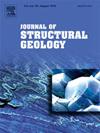Switching from contractional to extensional tectonics along the Alpine Front: structural and metamorphic evidence from the Balagne area (northern Corsica, France)
IF 2.9
2区 地球科学
Q2 GEOSCIENCES, MULTIDISCIPLINARY
引用次数: 0
Abstract
In the Corsica Island (France), the tectonic boundary along which the units of Alpine Corsica overlap the Hercynian Corsica represents a first-order structure which has not been investigated in depth yet. In this paper, the reconstruction of the Alpine Corsica Front in the Balagne area through the characterization of the deformation history and the associated peak metamorphism for the units of Alpine Corsica and for the Hercynian Corsica is provided. The collected data indicate that a gap in the peak metamorphism between the less metamorphic units located at the top of the unit pile, and those located at lower structural level which registered low-blueschist facies conditions exists. Also, a detailed structural analysis of the shear zones along the Alpine Corsica Front is supplied. The studied N-S trending, E-dipping shear zones documented at the western rim of the Balagne area are characterized by deformation history indicating a top-to-E sense of shear that overprint a former top-to-W kinematics. These findings indicate that the Alpine Corsica Front was affected by extensional tectonics after the shortening, which developed during the top-to-W thrusting of the Alpine Corsica onto the Hercynian Corsica. Framing our results in the regional tectonic setting, we suggest that the extensional tectonics documented in the Balagne area developed during the Oligocene-Early Miocene, i.e., during the transition from the latest stages of orogenic exhumation within the Alpine belt to the post-orogenic rifting stage in the Liguro-Provençal and Tyrrhenian Basins.
沿阿尔卑斯锋面从收缩构造转向伸展构造:法国北科西嘉Balagne地区的构造和变质证据
在科西嘉岛(法国),阿尔卑斯科西嘉板块与海西西科西嘉板块重叠的构造边界是一种一级构造,但尚未深入研究。本文通过对阿尔卑斯科西嘉单元和海西期科西嘉单元的变形历史和相关峰变质作用的描述,对巴拉格涅地区阿尔卑斯科西嘉锋面进行了重建。收集到的数据表明,位于单元堆顶部的变质程度较低的单元与位于较低构造水平的具有低蓝片岩相条件的单元之间存在变质峰隙。此外,还对阿尔卑斯科西嘉锋面的剪切带进行了详细的结构分析。在Balagne地区西缘记录的南北向、e倾剪切带的变形历史特征表明,从顶到东的剪切作用叠加了之前从顶到西的运动学。这些结果表明,高寒科西嘉锋面是在高寒科西嘉向海西西科西嘉由上至西逆冲过程中,受伸展构造缩短后的影响而形成的。在区域构造背景下,我们认为Balagne地区的伸展构造发育于渐新世-早中新世,即在利格罗-普罗旺帕拉盆地和第勒尼安盆地从阿尔卑斯带造山掘出的最新阶段到造山后裂谷阶段的过渡时期。
本文章由计算机程序翻译,如有差异,请以英文原文为准。
求助全文
约1分钟内获得全文
求助全文
来源期刊

Journal of Structural Geology
地学-地球科学综合
CiteScore
6.00
自引率
19.40%
发文量
192
审稿时长
15.7 weeks
期刊介绍:
The Journal of Structural Geology publishes process-oriented investigations about structural geology using appropriate combinations of analog and digital field data, seismic reflection data, satellite-derived data, geometric analysis, kinematic analysis, laboratory experiments, computer visualizations, and analogue or numerical modelling on all scales. Contributions are encouraged to draw perspectives from rheology, rock mechanics, geophysics,metamorphism, sedimentology, petroleum geology, economic geology, geodynamics, planetary geology, tectonics and neotectonics to provide a more powerful understanding of deformation processes and systems. Given the visual nature of the discipline, supplementary materials that portray the data and analysis in 3-D or quasi 3-D manners, including the use of videos, and/or graphical abstracts can significantly strengthen the impact of contributions.
 求助内容:
求助内容: 应助结果提醒方式:
应助结果提醒方式:


